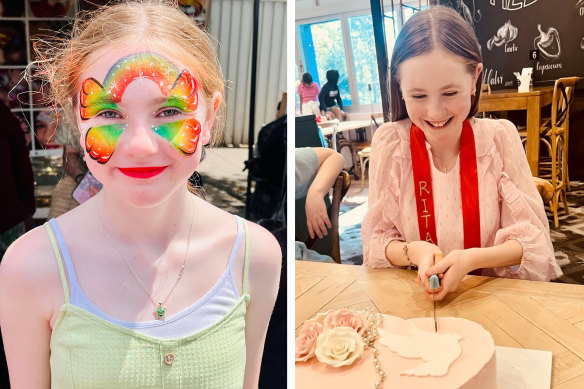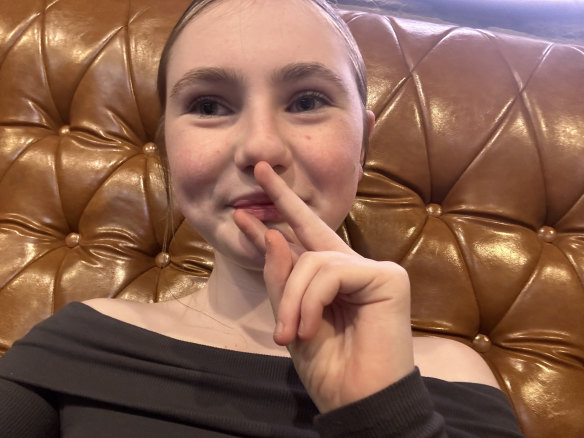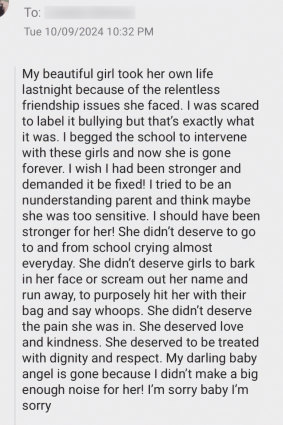By Jordan Baker
On a Tuesday night, a mother sent a message to her daughter’s school. It was thick with shock, sorrow and guilt. Charlotte, who had faced “relentless friendship issues” and cried on her way to class almost every day, had been found dead that morning. Her farewell note cited bullying. She was 12 years old.
“I was scared to label it bullying but that’s exactly what it was,” her mother’s message to the school read. “I’d begged the school to intervene … now she is gone forever. I wish I had been stronger. My darling baby angel is gone because I didn’t make a big enough noise for her. I’m sorry, baby, I’m sorry.”

Charlotte, aged 12, died last Monday night. Her family are critical of her school’s response to claims she was bullied.
Charlotte’s death has shocked Sydney and raised questions about how schools are handling bullying. Rachael Murrihy from The Kidman Centre says many institutions don’t know what to do about it, and parents and educators were resorting to lawyers to represent or investigate students.
Charlotte’s parents told 2GB broadcaster Ben Fordham on Monday that they did not blame their daughter’s fellow year 7 students – “they are just little girls” – but had repeatedly asked for help from her school, Santa Sabina College in Strathfield.
The school’s response was that the family’s allegations were new and inconsistent with their records. In a statement on Tuesday, Charlotte’s parents said there must be an issue with the records or “they’re calling us liars. We’re passing on a message from our daughter. Our daughter is not a liar”.
Messages seen by this masthead show Charlotte’s mother raised her daughter’s welfare with the school as far back as August 2022. She told them Charlotte, then in year 5, had disclosed highly personal information to other girls. She was “so worried” about her daughter being bullied as a result.

Sydney school student Charlotte, aged 12, took her own life a week ago.
In response to her concerns, the school stated it took bullying extremely seriously. The parents told Fordham the issues continued, and they raised the matter verbally with the school at least a dozen times. They’d also taken Charlotte to therapy, to a doctor, and were looking for a new school.
As recently as early August this year, her mother sent Santa Sabina a message saying Charlotte was too distressed to attend because she had been “coming home in tears”.
In her griefstricken letter sent on September 10, Charlotte’s mother said her daughter didn’t deserve girls to “bark in her face or scream out her name and run away, to purposely hit her with their bag and say whoops. She deserved love and kindness.”

The message sent by Charlotte’s mother to the school after her daughter’s death.
Charlotte’s death is the second suicide connected to the Santa Sabina community this year. A senior finance administrator took her own life in early January, within 10 days of resigning from a job she’d held for less than six months. She told family and friends there was a culture of bullying at the school.
Experts say suicide is complex and is rarely attributable to a single factor. They say the most common risk factors for youth suicide are a mental health condition or a physical disability, but bullying, family problems and grief are also risk factors.
In a response to questions from this masthead, Santa Sabina’s principal Paulina Skerman said she would not comment further on Charlotte’s family’s interactions with the school out of respect for the family’s grief, beyond the statement the school issued on Monday noting inconsistencies with records.
Skerman was also unable to comment on the mental health of the former staff member but said the school had never received any reports from her or her family that she felt victimised. Skerman was on a flight to Perth when she received the news of Charlotte’s death and returned on the first flight available.
The school is concerned about the welfare of its students and has called in counsellors, mental health experts from Headspace and chaplains. Santa Sabina’s bullying policy was updated in March 2023.
Murrihy said schools were struggling to deal with bullying; they did not know what level of seriousness should trigger an investigation, who should investigate, and how the victim and bully should be managed before anything was proven. They also did not know where to get evidence-based advice.
Parents of bullies were calling in solicitors to contest allegations, while high-fee independent schools were increasingly hiring lawyers to conduct investigations. “Right down to the interview, you’re handing this over to a lawyer with potentially no adolescent expertise to handle a traumatic incident,” Murrihy said.
Parents also felt disempowered and did not know when reporting something might make it worse – boys in particular have a strong anti-snitching code – how to do it, and how much follow-up they could expect. Some schools give very little information, citing the privacy of the perpetrator.
If an investigation is long, the victim must attend school with the alleged offender due to the presumption of innocence. “Often there’s two points of trauma, there’s the bullying in the first place and there’s the handling of it by the school,” Murrihy said. “It’s not something that’s intentional but it’s a significant problem.”
Bullying was tied to wider discipline problems in Australian schools, said Tim McDonald, who has advised government on student behaviour. “It is getting hidden underneath the disruptive and disengaged behaviours in the classroom and around the school grounds, because it becomes part of the noise, part of the chaos,” he said.
A key message when discussing suicide with children was that no problem is irresolvable. “The important thing is when you have problems, you reach out to someone; problems can always be worked through,” Murrihy said.
Charlotte’s parents gave permission for their daughter’s first name and photograph to be used.
Support is available through Kids Helpline on 1800 55 1800, Beyond Blue on 1300 224 636, Lifeline on 13 11 14, Sane on 1800 187 263, and Dolly’s Dream on 0488 881 033.
Start the day with a summary of the day’s most important and interesting stories, analysis and insights. Sign up for our Morning Edition newsletter.